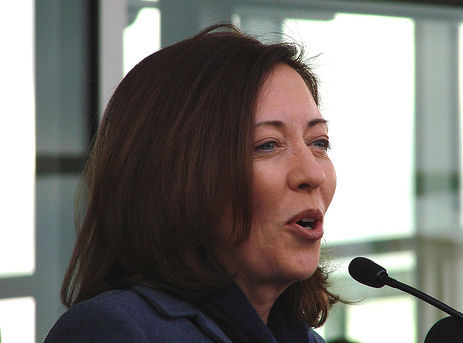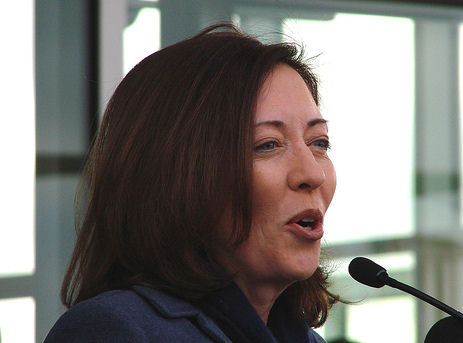Last week saw two interesting developments in the ongoing saga of the U.S. Senate’s struggle with a climate/energy bill.
First, Sens. John Kerry, Lindsey Graham, and Joseph Lieberman released the framework for the bill they’re working on, which basically amounts to the bill the House and the Senate Environment committee passed plus a thick layer of subsidies for nuclear power and offshore drilling meant to attract some Republican votes. Second, Sens. Maria Cantwell and Susan Collins released the text of their CLEAR (Carbon Limits and Energy for America’s Renewal ) Act, which, as an alternative to Kerry’s bill, added a degree of uncertainty to the Senate process.
With regard to CLEAR, three questions are on everyone’s mind: Is it a better bill? Can it pass? And how will it affect Senate climate politics? My take, in brief: no, no, and who knows. Details:
Is it a better bill?
The answer to this, I say at risk of getting yelled at by a lot of my colleagues in the green world, is pretty clearly No. I highly, highly recommend the superb analysis of the bill from the guys at Sightline, which lays out exactly why.
Many in the green world rushed to praise the bill, because it contains several features for which they have long advocated. It auctions 100 percent of the pollution allowances (unquestionably a good thing); it returns most (75 percent) of the revenue directly to consumers (less of a home run than it’s made out); it prevents a broad market in CO2 allowances (way less of a home run than it’s made out); and it preserves EPA authority to regulate CO2 (a good thing, but like the public option, ill-suited to being the red line for progressive support).
Again, I recommend the Sightline analysis for more details on this stuff. Here, quickly, are what I see as the biggest flaws in the bill relative to Kerry’s:
- The cap is aspirational, not mandatory, and weak regardless. Cantwell and Collins say they want 20 percent reduction by 2020, but the carbon price will only secure 5 percent. The rest is attributed to the 25 percent of revenue not rebated to consumers, which the authors say will be spent on a grab bag of clean energy investments. But that 25 percent, in order to avoid the CBO haircut, runs through the conventional appropriations process. That means the authors can’t say with any certainty how the money will be spent. That’s a rather glaring flaw, since they’re freighting those investments with some 75 percent of their emissions reductions. The fact is, there just won’t be enough money in that 25 percent to accomplish their goals; the result will be far less investment than Kerry’s bill offers and far, far less than what’s needed. And incidentally: if Cantwell/Collins are allowed to count reductions from their complimentary policies, why isn’t Kerry’s bill afforded the same consideration? Analysis from the World Resources Institute shows that those policies will get Kerry’s bill up to about 28 percent reductions by 2020. (For an interesting take on how counting these complementary reductions could affect the Copenhagen process, see Andrew Light.)
- Despite the hype, markets help reduce costs. Restricting trading to regulated entities (the limited set of fossil fuel companies that will buy allowances at auction) will actually encourage rather than discourage price manipulation. And with brokers excluded from the market, power companies (et al) will have more trouble, not less, hedging against long term swings in carbon prices. People seem to forget this in the recent anti-market climate, but there’s a reason greens preferred cap-and-trade in the first place, and it has to do with the flexibility markets provide. There’s no way to legislate this extremely contentious issue here, but for a balanced take see Brad Plumer’s great article in the latest issue of TNR.
- There’s no money for protecting manufacturers or aid to developing countries. These provisions are central to domestic negotiations on climate policy and climate talks in Copenhagen, respectively. Their absence from the CLEAR Act is a political liability.
CLEAR’s supporters tout its simplicity and brevity (it’s only 40 pages!), but a closer look makes clear that it’s simple and short because it fails to flesh out crucial details and simply neglects a great many important issues. (There’s a reason Kerry’s bill is long.) In sum, as written, it would produce fewer emission reductions and fewer jobs than Kerry’s bill, at a higher price. The welcome presence of a few excellent provisions shouldn’t obscure that larger fact.
Can it pass?
CLEAR is not an obvious nonstarter. It’s more bipartisan than Kerry’s bill, seeing as how neither Graham nor Lieberman has signed on as a co-sponsor. A few moderate Senate Dems like Jim Webb and Byron Dorgan are allegedly making supportive noises about it (though none of them has signed on as a cosponsor either). At least in theory, a few Republicans from oil states (oil is seen, rightly, as getting screwed relative to coal in Kerry’s bill) might be persuaded to sign on.
But I’ve yet to hear a remotely convincing case that it can get to 60. Coal-state Dems are worried their states will get hit disproportionately, and there’s nothing in CLEAR to address regional disparities. They would almost certainly bail. Could their numbers be supplanted by a sufficient number of moderate Republicans? Anything can happen, but count me skeptical of any political strategy that rests on cooperation from any but a tiny and dwindling number of moderate Senate Republicans.
And remember, this isn’t just about the merits of the respective bills. Getting CLEAR to 60 would involve the Senate collectively bailing on a framework that’s passed the House, has Obama’s support, is consonant with the international approach, already reflects the concerns of dozens of stakeholders, and has a non-trivial chance of passing next year. Now, there’s certainly no guarantee Kerry’s bill can pass. The smart money is probably against his or any other bill passing. But to bail on Kerry and move en masse to Cantwell would be an act of fairly radical boldness on the Senate’s part, and the U.S. Senate does not do radical or bold.
How will it affect Senate climate politics?
This is the key question, and the most difficult to answer. Worst case scenario, CLEAR confuses and even further slows the process. You end up with two competing blocs, neither large enough to pass a bill. The famous liberal circular firing squad forms and the process collapses. No consensus, no bill.
Best case scenario, support for CLEAR convinces supporters of Kerry’s bill to strenthen it in ways responsive to CLEAR’s values. Kerry uses the boost to raise the number of allowance auctions, simplify the allocation process, reduce the number of offsets, and implement tighter restrictions on carbon trading and offsets. The bill is improved, Cantwell and her moderate Dem friends get credit and cover to sign on, and all is right with the world.
Anyone who claims to know how it will play out is blowing smoke — there are too many moving parts, circumstances are fluid, etc. All you can really do is stay tuned. Oh, and call your senator!




